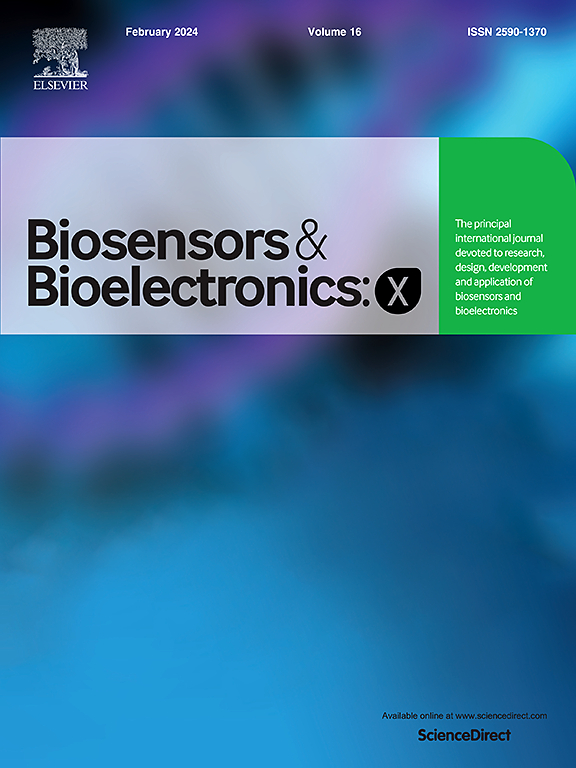Smartphone-based colorimetric detection of urinary glucose using a novel green and red/green approach
IF 10.61
Q3 Biochemistry, Genetics and Molecular Biology
引用次数: 0
Abstract
Urine dipsticks are commonly used to detect pathological changes in urine due to their low cost and easy operation, having glucose parameter to detect glucosuria. Despite their advantages, the urine dipstick is ineffective in the early detection of diabetes due to its limitations in the detection of glucose below 100 mg/dl. Here, we present a novel, cost-effective ambient ring light-based smartphone platform to accurately estimate urinary glucose concentrations in lower points utilizing glucose sensors obtained from commercially available urine dipsticks (Mission® and Recombigen™). Glucose sensors changed color from green to brown with the increasing glucose concentration, resulting in a response time of 5 min. In this study, smartphone was used to capture images and analyze Red-Green-Blue (RGB) profiles, extracted with the help of an open-source smartphone-android-based Color Picker app. G intensity was determined to be inversely proportional and R/G intensity to be directly proportional to the increasing glucose concentration. LOD was found to be 6.2 and 24 mg/dl for Mission® glucose sensors with G and R/G respectively. On the other hand, Recombigen™ dipstick glucose sensors, LOD was evaluated as 5.8 and 16 mg/dl with G and R/G respectively. This smartphone-based assessment of glucose using dipsticks can be beneficial in the current screening and diagnostics sector of earlier detection of glucose in urine.

基于智能手机的尿葡萄糖比色检测,采用一种新颖的绿色和红/绿方法
尿试纸成本低,操作方便,具有葡萄糖参数,可检测血糖,常用于检测尿液病理变化。尽管尿试纸有其优点,但由于其在检测葡萄糖低于100 mg/dl时的局限性,在糖尿病的早期检测中是无效的。在这里,我们提出了一种新颖的、具有成本效益的基于环境环光的智能手机平台,该平台利用从市售尿试纸(Mission®和Recombigen™)获得的葡萄糖传感器,准确估计低处的尿葡萄糖浓度。葡萄糖传感器的颜色随着葡萄糖浓度的增加从绿色变为棕色,导致响应时间为5分钟。在本研究中,使用智能手机捕获图像并分析红绿蓝(RGB)配置文件,并借助开源的基于智能手机android的color Picker应用程序提取。G强度被确定为反比,R/G强度与葡萄糖浓度的增加成正比。Mission®葡萄糖传感器的LOD分别为6.2和24 mg/dl,分别为G和R/G。另一方面,Recombigen™试纸式葡萄糖传感器的LOD分别以G和R/G计算为5.8和16 mg/dl。这种基于智能手机的葡萄糖评估使用试纸可以在当前的筛查和诊断领域早期检测尿液中的葡萄糖有益。
本文章由计算机程序翻译,如有差异,请以英文原文为准。
求助全文
约1分钟内获得全文
求助全文
来源期刊

Biosensors and Bioelectronics: X
Biochemistry, Genetics and Molecular Biology-Biophysics
CiteScore
4.60
自引率
0.00%
发文量
166
审稿时长
54 days
期刊介绍:
Biosensors and Bioelectronics: X, an open-access companion journal of Biosensors and Bioelectronics, boasts a 2020 Impact Factor of 10.61 (Journal Citation Reports, Clarivate Analytics 2021). Offering authors the opportunity to share their innovative work freely and globally, Biosensors and Bioelectronics: X aims to be a timely and permanent source of information. The journal publishes original research papers, review articles, communications, editorial highlights, perspectives, opinions, and commentaries at the intersection of technological advancements and high-impact applications. Manuscripts submitted to Biosensors and Bioelectronics: X are assessed based on originality and innovation in technology development or applications, aligning with the journal's goal to cater to a broad audience interested in this dynamic field.
 求助内容:
求助内容: 应助结果提醒方式:
应助结果提醒方式:


